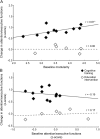Functional brain network modularity predicts response to cognitive training after brain injury
- PMID: 25788557
- PMCID: PMC4408280
- DOI: 10.1212/WNL.0000000000001476
Functional brain network modularity predicts response to cognitive training after brain injury
Abstract
Objective: We tested the value of measuring modularity, a graph theory metric indexing the relative extent of integration and segregation of distributed functional brain networks, for predicting individual differences in response to cognitive training in patients with brain injury.
Methods: Patients with acquired brain injury (n = 11) participated in 5 weeks of cognitive training and a comparison condition (brief education) in a crossover intervention study design. We quantified the measure of functional brain network organization, modularity, from functional connectivity networks during a state of tonic attention regulation measured during fMRI scanning before the intervention conditions. We examined the relationship of baseline modularity with pre- to posttraining changes in neuropsychological measures of attention and executive control.
Results: The modularity of brain network organization at baseline predicted improvement in attention and executive function after cognitive training, but not after the comparison intervention. Individuals with higher baseline modularity exhibited greater improvements with cognitive training, suggesting that a more modular baseline network state may contribute to greater adaptation in response to cognitive training.
Conclusions: Brain network properties such as modularity provide valuable information for understanding mechanisms that influence rehabilitation of cognitive function after brain injury, and may contribute to the discovery of clinically relevant biomarkers that could guide rehabilitation efforts.
© 2015 American Academy of Neurology.
Figures


References
-
- Cicerone KD, Dahlberg C, Malec JF, et al. Evidence-based cognitive rehabilitation: updated review of the literature from 1998 through 2002. Arch Phys Med Rehabil 2005;86:1681–1692. - PubMed
-
- Rubinov M, Sporns O. Complex network measures of brain connectivity: uses and interpretations. Neuroimage 2010;52:1059–1069. - PubMed
-
- Simon HA. The architecture of complexity. Proc Am Philos Soc 1962;106:467–482.
-
- Simon HA. Near-decomposability and complexity: how a mind resides in a brain. In: Morowitz H, Singer J, editors. The Mind, the Brain, and Complex Adaptive. Reading, MA: Addison-Wesley; 1995:25–43.
